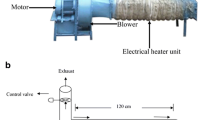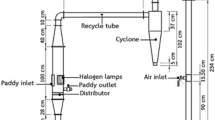Abstract
Rice is one of the important food crops in Indonesia. It is known as a staple food of Indonesian society. The consumption patterns of rice are slowly but surely increase with increasing income, education and access to information. Increasing demand for rice in the country reaches 1.6% per year. One of the problems that arise in the process of rice production is the drying process. Generally, the unhulled rice drying process in Indonesia is carried out directly in the sun. This method has many limitations. In this study, the drying method used is a fluidized bed. The purpose of this study is to determine the effect of the intake air temperature and unhulled rice mass on drying time. The intake air temperatures used were 40, 45, 50 °C. The results show that the fastest drying process to obtain the final moisture content of 13.1% from the initial moisture content of about 22% is achieved using the intake air temperature of 50 °C. The drying process takes about 40 min; however, the increased drying process speed is not linearly with the increase in the intake air temperature.







Similar content being viewed by others
Abbreviations
- A :
-
Cross-sectional area (m2)
- C p :
-
Heat specific (J/kgK)
- C pu :
-
Air heat specific (J/kg°C)
- d p :
-
Particle diameter (m)
- εmf :
-
Porosity
- E :
-
Energy (J)
- E 1 :
-
Sensible heat (J)
- E 2 :
-
Water sensible heat (J)
- E 3 :
-
Water latent heat (J)
- E u :
-
Energy supplied to the fluidized bed (J)
- h fg :
-
Energy of evaporation (J/kg)
- KA i :
-
Initial moisture content (%)
- m kp :
-
Mass of dry product (kg)
- m t :
-
Total mass of product (kg)
- m w :
-
Mass of the water (kg)
- T fp :
-
Final temperature of the product (°C)
- T ip :
-
Initial temperature of the product (°C)
- U mf :
-
Minimum velocity of fluidization (m/s)
- V :
-
Velocity (m/s)
- V u :
-
Bed volume (m3)
- V p :
-
Particle volume (m3)
- ∀:
-
Volume (m3)
- \( \overset{\cdot }{\forall } \) :
-
Volumetric rate (m3/s)
- Δt :
-
Drying time (s)
- ρ p :
-
Particle density (kg/m3)
- ρ u :
-
Air density (kg/m3)
- η :
-
Efficiency
- T i :
-
Inlet air temperature (°C)
- T o :
-
Outlet air temperature (°C)
References
Sidik M (2006) Prospect of rice production and food security in East Asia, di dalam peningkatan daya saing beras nasional melalui perbaikan kualitas. Loka karya Nasional, Kerjasama Perum BULOG dengan FATETA IPB, Jakarta
Daulay SB (2005) Pengeringan padi (metode dan peralatan). JurusanTeknologi Pertanian Fakultas Pertanian Universitas Sumatra Utara
Djaeni M, Figiarto R, Ghalfani SL (2012) Peningkatan kualitas gabah dengan proses pengeringan menggunakan zeloit alam pada unggun terfluidasi. Jurnal Teknologi Kimia dan Industri 1(1):206–212
Fudholi A, Othman MY, Ruslan MH, Sopian K (2013) Drying of Malaysian Capsicum annuum L. (red chili) dried by open and solar drying. Int J Photoenergy:1–9
Palled V, Desai SR, Anantachar M (2012) Performance evaluation of solar tunnel dryer for chilly drying. Karnataka Journal of Agricultural Science 25(4):472–474
Herawan D (1992) Uji percontohan (pilot testing) pengering cabe merah (capsicum annuum L) tipe konveksi bebas untuk pengusaha tingkat pedesaan. Skripsi, FTP, IPB, Bogor
Mirmanto M, Sulistyowati ED, Okariawan IDK (2016) Effect of radiator type on dryer room temperature distribution and heat transfer rate. JP Journal of Heat and Mass Transfer 13(4):512–532
Mirmanto M, Syahrul S, Sulistyowati ED, Okariawan IDK (2017) Effect of inlet temperature and ventilation on heat transfer rate and water content removal of red chili. J Mech Sci Technol 31(3):1531–1537
Mirmanto M, Sulistyowati ED, Okariawan IDK (2016) Effect of radiator position and mass flux on dryer room heat transfer rate. Results in Physics 6:139–144
Syahrul S, Hamdullahpur F, Dincer I (2002) Thermal analysis in fluidized bed drying of moist particles. Appl Therm Eng 22:1763–1775
Arifianto B, Indarto (2006) Studi karakteristik fluidisasi dan aliran dua fase padat-gas (pasir besi-udara) pada pipa lurus vertikel. Media Teknik 2
Vistanty H (2010) Pengering pasta susu kedelai menggunakan pengering unggun terfluidakan partikel inert. Magister Teknik Kimia Program Pasca Sarjana Universitas Diponegoro, Semarang
Hargono DM, Buchori L (2012) Karakteristik proses pengering jagung dengan metode mixed-adsorption drying menggunakan zeolit pada unggun terfluidisasi. Reaktor 14:33–38
Widjanarko A, Ridwan, Djaeni M, Ratnawati (2012) Penggunaan zeolite sintetis dalam pengeringan gabah dengan proses fluidisasi indirect contatct. Jurnal Teknologi Kimia dan Industri 2(2):103–110
Graciafernandy MA, Ratnawati, Buchori L (2012) Pengaruh suhu udara pengering dan komposisi zeolit 3a terhadap lama waktu pengeringan gabah pada fluidized bed dryer. Momentum 8(2):6–10
Fatchurrozi (2011) Analisis desain fungsional dan kondisilingkungan mikro pada gudang beras:studi kasus gudang bulog dramaga – Bogor. Skripsi, Institut Pertanian Bogor
Soerjandoko RNE (2010) Teknik pengujian mutu beras skala laboratorium. Balai Besar Penelitian Tanaman Padi, Buletin Teknik Pertanian 15(2):44–47
Mahadi (2007) Model system dan analisa pengering produk makanan. USU Repository, Universitas Sumatra Utara
Yahya M (2015) Kajian karakteristik pengering fluidisasi terintegrasi dengan tungku biomassa untuk pengering padi. Jurnal Teknik Mesin 5(2):65–71
Hasibuan R (2005) Proses pengeringan. Fakultas Teknik Universitas Sumatra Utara, Program Studi Teknik Kimia
Tanggasari D (2014) Sifat teknik dan karakteristik pengering biji jagung (Zea mays L.) pada alat pengering fluidized bed. Fakultas Teknologi Pangan dan Agroindustri Universitas Mataram
Ardani RK, Pradana RN, Nurtono T, Winardi S (2013) Review pengaruh hidrodinamika pada fluidized bed dryer. Jurnal Teknik Pomits 2(3):2
Kunii D, Levenspiel O (1991) Fluidization engineering, 2nd edn. Howard Brenner, Affiliations and Expertise, Massachusetts Institute of Technology, USA
Syahrul S, Dincer I, Hamdullahpur F (2003) Thermodynamic modeling of fluidized bed drying of moist particles. Int J Therm Sci 42:691–701
Holman JP (1994) Perpindahan kalor. Erlangga, Ciracas
Husain S, Horibe A, Haruki N (2007) Heat and mass transfer analysis of fluidized. Memoirs of the Faculty of Engineering, Okayama University 41:52–62
Syahrul S (2016) The effect of the initial mass of shelled corn for fluidized bed drying system. International Journal on Smart Material and Mechatronics 3(2):1–3
Acknowledgments
The author would like to acknowledge the Ministry of Research, Technology and Higher Education of Indonesia for the funding through a research grant 2017 and 2018.
Author information
Authors and Affiliations
Corresponding author
Additional information
Publisher’s Note
Springer Nature remains neutral with regard to jurisdictional claims in published maps and institutional affiliations.
Rights and permissions
About this article
Cite this article
Syahrul, S., Mirmanto, M., Hartawan, Y. et al. Effect of air intake temperature on drying time of unhulled rice using a fluidized bed dryer. Heat Mass Transfer 55, 293–298 (2019). https://doi.org/10.1007/s00231-018-2414-3
Received:
Accepted:
Published:
Issue Date:
DOI: https://doi.org/10.1007/s00231-018-2414-3




